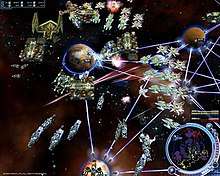New Space Order
New Space Order[lower-alpha 1] is an unreleased real-time strategy arcade game under development by Namco Bandai Games for Japan. Controlling a fleet of battleships, players would explore the void of space to gather resources and fight off enemy fleets and destroy entire planets. Players could construct network systems to distribute resources to other players and construct new ship types to deploy into battle. The plot involves an intergalactic organization, the United Galaxy Space Force, discovering an unknown extra-terrestrial species that plans to wipe out all of mankind. It was made for the Namco System N2 arcade board.
| New Space Order | |
|---|---|
 Official game logo. | |
| Developer(s) | Project Starline |
| Publisher(s) | Namco Bandai Games |
| Director(s) | Toru Takahashi |
| Platform(s) | Arcade |
| Release | Cancelled |
| Genre(s) | Real-time strategy |
| Mode(s) | Multiplayer |
| Arcade system | Namco System N2 |
Development of the game was done by internal development group "Project Starline", lead by Toru Takahashi. Inspired by the Age of Empires series, the team wanted to create a game that would help set a standard for Japanese online games, which were deemed inferior in quality to those overseas. The game was meant to be part of Namco's fictional "United Galaxy Space Force" saga and used ships and settings from other Namco video games, including Galaxian, Galaga, Xevious and Starblade. Beta testing for the game was exclusive to Namco-operated cafe chains in Japan. New Space Order was shown off at the 2007 Amusement Operators Union (AOU) tradeshow, which was followed by a tie-in anime series, New Space Order: Link of Life. Updates for the game would continue to decrease in the years following, and development was officially ceased in 2009 with little to no explanation.
Gameplay

New Space Order was described as a "Namco space opera". Up to eight players controlled a fleet of battleships as they must explore the universe in search of the "enemy star". Ships included large-scale war machines, small drones and turret guns. Similar to the Age of Empires series, the map will begin as entirely black, revealing more of the world as the player explores. Ships can be deployed to fend off enemy formations approaching the player or their base. A "planet buster" weapon can be deployed against enemy planets to instantly wipe them out, with one taking the form of Zolgear from the arcade game Attack of the Zolgear.
Players could gather resources by exploring space, and could also distribute them to other players through tube-based network systems. Resources could be used to construct new ship types and weapons. Several ships are based on those found in other Namco shooting games, such as Galaxian, Galaga, Star Luster and Ace Combat 3: Electrosphere. A short tutorial was present to teach the player how to play the game. Maps were randomly-generated and could take the form of various designs, including a recreation of the maze from Pac-Man. The game was played using a mouse and keyboard. An IRC card was used to save player progress. The arcade cabinets could be linked together to allow for additional players, the maximum being eight.
History
Development
New Space Order began development in 2004 by "Project Starline", an internal development group in Namco headed by director Toru Takahashi. Prior to development, most real-time strategy games in Japan had been placed in a negative light for being inferior in quality to those from North America and Europe.[1] Takahashi, a fan of the Age of Empires series, set out to design a similar game in higher quality to help set a standard for future games of its kind in Japan.[1] It was to be Namco's very first real-time strategy game and one of their first online-focused titles.[1] The game was centered around the United Galaxy Space Force universe that combined characters, ships and settings from other Namco titles, including Galaxian, Galaga, Bosconian, Xevious, NebulasRay, Starblade and Ace Combat.[1]
Originally, the game was to instead feature futuristic tank combat instead of large-scale wars in space — although a fan of the idea, Takahashi thought that the space theme was more interesting and could help focus more on combat and strategy.[1] The team had difficulty defining the most important aspects for the game, as Namco had previously never made a game similar to theirs.[1] Takahashi wanted the game to appeal to a wider audience so as to help the game get a foothold in the market.[1] The team also wanted players to work together, leading to the addition of resource-sharing link systems.[1] Beta testing began on August 26, 2004, taking place in Namco-operated cafe chains across Japan.[2]
Promotion and cancellation
New Space Order was presented at the Amusement Operators Union (AOU) tradeshow in Japan on February 16, 2007, alongside other Namco Bandai titles such as Tekken 6, Mario Kart Arcade GP 2 and Wangan Midnight: Maximum Tune 3,[3] where it had attracted a sizable amount of attention.[4] The game was housed in arcade cabinets previously used for Counter-Strike Neo, fitted with a mouse and keyboard.[5] Despite its attention, critics felt that the game was better-suited as a PC title and didn't feel the idea of a real-time strategy game would fit for arcades, somewhat criticizing Namco Bandai Games for not announcing a PC port of the game. Shortly after the tradeshow, a tie-in anime series, New Space Order: Link of Life, was released exclusively for the game's official website to help explain the story. After a lack of updates for nearly two years, the official website for the game announced its cancellation on January 27, 2009, citing "various circumstances" as its reason.
Reception
- TAITA (20 December 2004). "ナムコが手がけるSF RTS「NEW SPACE ORDER」開発者インタビュー". 4Gamer.net. Archived from the original on 26 August 2016. Retrieved 10 August 2019.
- "ギャラクシアンの流れを組むRTS!? ナムコが手がけるSF RTS「NEW SPACE ORDER」,βテスト中". 4Gamer.net. 14 September 2004.
- Epperson, Justin (17 February 2007). "AOU Japanese Arcade Show Report". 1UP.com. Archived from the original on 30 July 2012. Retrieved 10 August 2019.
- "AOU2007アミューズメント・エキスポで『鉄拳6』の映像が公開! 【『鉄拳6』の動画追加!】". Famitsu. Enterbrain. 16 February 2007. Archived from the original on 9 September 2013. Retrieved 10 August 2019.
- Saeki, Kenji (16 February 2007). "AOU2007 アミューズメント・エキスポ」ブースレポート ~バンダイナムコゲームス編~ レースゲーム2タイトル、キッズ層向けビデオゲームも出展". GAME Watch. Impress Group. Archived from the original on 7 August 2017. Retrieved 10 August 2019.